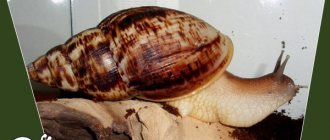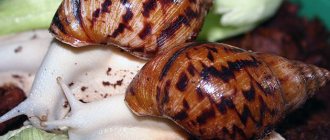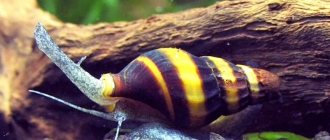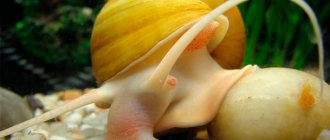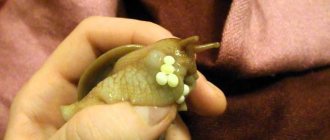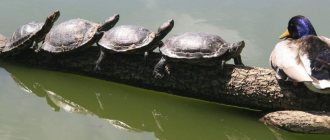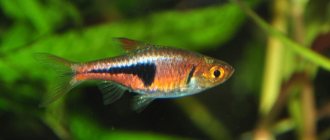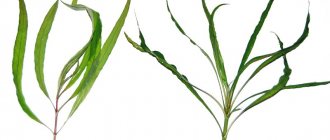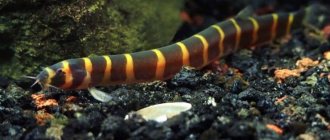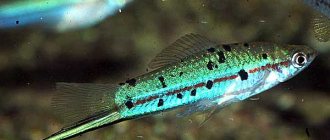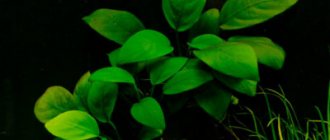A few facts about the snail that you need to know before buying it
- Achatina live 10 years, but in captivity they often live up to 6-7 years;
- Snails can reach 25 cm in length;
- Land mollusks are hermaphrodites, they have female and male genital organs;
- Achatina is very prolific. The number of eggs in a clutch can reach 500 pieces;
- Mollusks are deaf and have poor eyesight;
- Under unfavorable conditions they hibernate;
- Achatina are vegetarians. They need calcium to build a beautiful, large shell.
Achatina albino as a pet
Snails are ideal pets for almost everyone. First of all, they are unusual animals. Secondly, snails are omnivorous and unpretentious in food and care. Thirdly, these are exotic pets.
Achatina albinos have no smell, do not make a sound, do not bite or scratch, and do not need to be walked or played with on a daily basis. Also, people are not allergic to them, so they are used in cosmetology - snail therapy.
Two-horned pets are perfect as pets for busy people and children, as they require a little of your attention and time. Mollusks have one vulnerable spot - the shell. If it is seriously damaged, the mollusk most often dies.
Snail selection
There are a great many species and varieties of Achatina snails. Achatina differ from each other: in size, color and pattern on the shell.
Almost all types of African snails are albino in color.
Most often at home they contain:
Achatina Fulica is the most common type of snail and comes in many different shell and body colors. Grows up to 20 cm in length. Unpretentious and very sociable.
Achatina achatina, grows up to 25 cm in length. In terrariums they are not found as often as fulica. They are more demanding of temperature and humidity, and are also reluctant to reproduce at home.
See more similar articles:
How to choose an aquarium for keeping the Achatina snail:...
Terrarium for the Achatina snail - rules and examples...
Back Forward 1 of 16
Achatina albinos grow very intensively up to a year. Then their growth slows down or stops completely.
If you choose an albino snail, be prepared to buy it at a pet store or from trusted breeders. Be sure to ask her parents, look at their photographs. This will guarantee that the offspring of your snail will also be albinos. It wouldn’t hurt to ask what kind of soil the snail was kept on and what its favorite food was. Read how to grow a big snail here.
Kinds
In total, there are about 100 species of giant snails in nature, but the range of individuals that are suitable and most popular for home keeping amounts to only two dozen names.
It will be useful for you to read about how to care for Achatina snails at home.
Particularly popular among them are:
- Achatina fulica. A sedentary mollusk that is active only at night, but during the day it prefers to rest in a secluded place. It has an unusual shell: its color changes depending on what the snail has eaten. The body is brown, massive, and has characteristic tubercles. The maximum growth of this species is up to 22 cm.
- Albino - can be fulica, reticulata, tiger. Its peculiarity is a white body with a light or yellow shell. Maximum length - up to 15 cm.
- Tiger - has a barrel-shaped shell decorated with dark orange stripes. An adult specimen grows up to 25 cm. It was this species that was included in the Guinness Book of Records: the largest land mollusk was the tiger Achatina, which grew to 39 cm in length and weighed 900 grams.
- Reticulata blackhead — a feature of this species is the black head, and sometimes the entire body of the mollusk. Baby black-headed reticulata have cherry dots and stripes on their carapace, which return to their natural color as they age.
- Achatina immaculata - has a light beige shell with a dark mesh pattern. The maximum size of this species reaches 17 cm, and weight - 200 g.
There are 3 main degrees of body color in all types of Achatina: white (albino), light (beige and brown) and dark (brown or black). It is noteworthy that snails always interbreed only within their own species.
Terrarium for an albino snail
A plastic or glass container with a ventilated lid is an ideal housing for Achatina. An old aquarium or plastic food container will also work. The container size must be at least 20 liters. If you have not one, but several snails, then you need a lot of space for them to live. They don't like close quarters. Give preference to low and wide terrariums. Don't forget to ventilate the terrarium and place a thermometer and hygrometer. Read more about arranging a terrarium.
A glass terrarium heats up quickly, but also cools down quickly.
Heating in the terrarium
During the cold season, the terrarium needs to be heated. Most albinos do well at a room temperature of 22-25 degrees, but if your snail becomes lethargic and does not eat well, you need to increase the temperature in the terrarium. They need warmth and humidity to live comfortably. To heat the terrarium, use a thermal mat or a regular light bulb. If the soil is dry, spray it 1-2 times a day.
Achatina in a food container
Snail home
Usually, special terrariums are purchased for snails, but an aquarium or even a plastic container will work just fine. The main thing is to maintain the calculation for 1 pet, the volume is 6 liters. The more, the better the pet will grow. At the very bottom we fill in sphagnum, soil for plants without fertilizer and additives, or a special mat at 6–7 cm.
Terrarium for Achatina
You can also put moss or dried leaves so that you have somewhere to bury yourself. You can place a lid with water in the corner for better humidity. You need to spray with warm water 1-2 times a day (as the humidity level decreases). You need to clean your home at least once a month. It is advisable to place the container in a place where there is no strong sunlight or drafts.
Primer or substrate for the snail
Achatina needs a humid climate and soil. They like to dig and burrow into the soil to rest and lay eggs.
Soil for an albino snail should not contain pesticides, salts, fertilizers, plant products, or peat. You can buy a good substrate at a pet store or prepare it yourself.
Coconut substrate, which is coconut fiber, is considered the most common type of soil. It holds moisture well and does not stain the walls of the terrarium.
Sphagnum moss is also a good substrate, which is often used as an independent or combined soil for snails. Moss retains moisture well, does not stain the terrarium and serves as additional food for Achatina.
The soil is changed once a month, completely or partially.
The soil should always be moist, but do not make it muddy or swampy. Spray water in the terrarium daily and monitor the behavior of your animals. If the shellfish are sitting on the wall or lid of the container, then moisten it every two days. Stones, sand and sawdust are not suitable for snails as soil. They dry quickly and scratch the shell and body of the mollusk.
Reproduction at home
Breeding Achatina is a fairly simple task; then it is much more difficult to find hosts for dozens, or even hundreds of small snails. Therefore, think very carefully whether you really want to breed.
Achatina are hermaphrodites: they have no males or females, but they are not capable of self-fertilization. You still need a pair of snails to reproduce. Therefore, if you don’t want problems with offspring, get just one snail. In a pair, one of the Achatina always takes on the role of the “male”, and the second - the “female”. Very rarely, two individuals give offspring at once.
They become sexually mature at 6 months. Achatina's genitals are located on the neck and look like a small, light-colored tubercle. Many people get scared when they see such a lump on their pet’s neck, but this is not a sign of disease, but evidence that she is ready to reproduce.
Sick snails and relatives should not be allowed to breed.
The first clutch of Achatina may be false - the snail lays 10-15 translucent unfertilized eggs without a shell. In subsequent times, the eggs will be white and in shell and with a diameter of 4-6 mm. Their number increases by several dozen with each clutch and can reach 400 pieces.
How to care for Achatina snail eggs:
- The masonry must not be touched with hands. But if the snail has deposited it all over the bottom, you need to carefully collect it with a spoon and put it in one place, and then sprinkle it with a little soil.
- Leave 10-15 of the largest eggs , the rest are thrown away or frozen.
- It is necessary to maintain the room temperature from +28°.
- The soil should be moist but not wet.
Decorating a terrarium for a snail
The snail's home can be decorated with natural and artificial accessories. Interesting twisty driftwood and branches, cork bark or artificial aquarium plants. You can decorate an aquarium with Achatina with live plants or sow seeds of mustard, wheat, oats, be prepared that over time they will be eaten.
Be creative when decorating your snail's home. Avoid stones in the terrarium, as if a snail falls on them from a height, the consequences can be fatal.
You can stick a poster on the back of your terrarium with different images on it, such as plants, cities, mountains, cartoon characters.
Plastic flower pots (clean and empty) make an excellent hiding place for your snail to nap and rest during the day. Avoid using those made of ceramic or stone.
Feeding and water
Feed the snail 1-2 times a day with fresh vegetables and fruits. Always wash them before giving them to your Achatina.
The clam should always have calcium. Edible chalk, sepia, eggshell, shell rock.
All these products can be purchased at any pet store or online. Snails need them for shell growth and proper development. Recipes for nutritional supplements for rapid snail growth.
Vegetables and fruits
- Lettuce leaves
- Broccoli
- Cauliflower
- Tomato
- Carrot
- Apple
- Pears
- Clover leaves
- Pumpkin seeds
- Raisin
- Turnip
- Peas
- Mushrooms
- Cucumber
- Celery
- Strawberry
- Watermelon
- Banana
- Raspberries
- Zucchini
- bell pepper
- Sweet corn
Water for Achatina
Place a plastic bowl of clean drinking water in the terrarium. Snails will not only drink from it, but also swim. Monitor the purity of the water and the depth in the container. Read about the importance of water for snails here.
Foods your snail shouldn't eat
Onions, pasta, anything with salt or sugar. Spicy and smoked.
What to feed Achatina?
If you want a pet like an African snail, care and nutrition are the main conditions for its healthy and long life. The mollusk eats plant foods: lettuce, cabbage, cucumbers, bananas, tomatoes, pumpkin, berries, sweet peppers, zucchini, melon, watermelon rinds. Egg whites or poultry meat in small quantities should be given only occasionally.
In summer you need to bring dandelion and clover leaves.
There should always be sepia, eggshells and chalk in the house; snails eat this mineral supplement, it is needed for the growth and strength of the shell.
There should always be a shallow container of clean water.
Bell pepper
How to pick up a snail
You can take your pet when the snail grows up and is not scary to hold in the palm of your hand. Try to handle babies less often to avoid damaging them. Before handling Achatina, wash your hands thoroughly with warm, clean water or wear latex gloves. The palm or glove should be damp.
Never pick up a snail by its shell, as you may pull it out completely, damaging the internal organs of the mollusk. Crush or damage the fragile walls of the Achatina shell. Try to take the snail from the ground, gently and carefully place your finger under it, when the snail moves onto your palm, hold it with your other hand.
The older Achatina gets, the less fear she will have of communicating with you. They are friendly and curious pets. If your children help you care for snails, warn them to handle these exotic mollusks with care and attention. And don’t forget to wash your hands with soap after interacting with the African snail.
Bathing or snail hygiene
Water procedures bring a lot of positive emotions to Achatina and their owners. You can gently wipe the strong shell and delicate body of the mollusk with a soft brush or sponge. To bathe snails, use clean boiled or filtered water, which is poured into a shallow container. Never keep your snail under a tap or in a deep bowl when their breathing hole becomes full - they will drown.
After bathing, gently dry the sink with a towel and lubricate it with natural vegetable oil (olive, pumpkin). If your terrarium has a drinking bowl with boiled water, make sure it is clean, as the snails will constantly “hang out” in it.
Never wash your snail with soap.
Nutrition
You need to feed your pets mostly fresh plant foods. You can also include in their diet:
- boiled egg;
- boiled potatoes;
- ripe bananas;
- boiled or steamed porridge;
- low-fat milk (can be diluted with water);
- sour cream.
It is strictly forbidden to feed:
- sweet;
- sharp;
- salted and peppered;
- fried and so on.
Snails, when there is not enough calcium in the body, can gnaw the shell of their neighbors and stop the growth of the shell. Then it is urgently necessary to introduce into the diet:
- sepia;
- feed chalk;
- gammarus;
- ground egg shell;
- not fatty cottage cheese;
- grain mixtures and porridge mixtures (ground in a coffee grinder).
Snail cleaning
It is carried out once every 3-4 weeks, depending on the size of the terrarium and the number of snails living in it. Wash the terrarium, bowls and decor only in warm water, then pour boiling water over everything. Replace all or part of the substrate, branches and snags. Some substrates can be processed and reused, but are easier to replace.
Bathing
Mollusks love to take water treatments. You can put a bath of clean water in the aquarium so that they can bathe. Give your pets a warm shower once a week. Hold it in your hand or in a plastic container with holes over the sink and direct a not very cold stream of water onto the house and body. He himself sticks out at full length from the shell and tries to expose his body to the drops of water.
Bathing Achatina
Reproduction
Achatina snails live in pairs. They are hermaphrodites, so both mollusks are fertilized and lay eggs. Control the clutches in your terrarium. Adult and small snails should live separately from each other, since babies can cause irreparable damage to the shells of adult animals, and there is not enough space for all of them in one terrarium. Read more about caring for Achatina masonry in the article.
